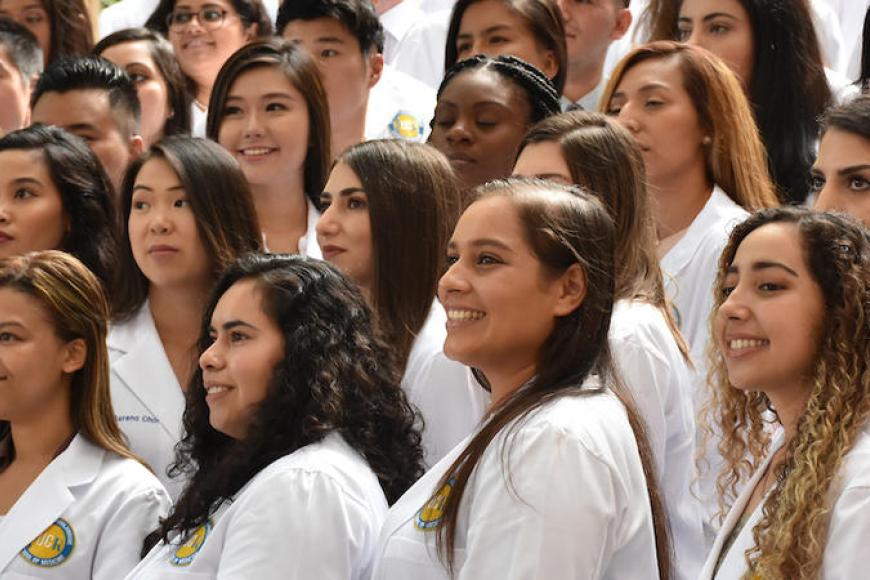The COVID-19 pandemic exposed longstanding health disparities. Racial disparities in health are substantial and continue to result in adverse outcomes for people of color.
These disparities can be found in measures that include life expectancy, mortality, morbidity, health status, disease prevalence and incidence, utilization of services, diagnosis and process of care, adequacy of pain management and end-of-life care.
The American Medical Association has declared that racism is a public health crisis, and University of California Health agrees. To build a more equitable health care system, we look for renewed leadership commitments and partnerships with accountability, plus new voices.
UC Health Sciences Diversity, Equity and Inclusion Report
View Disrupting the Status Quo: A Special Report of the UC Health Sciences Diversity, Equity and Inclusion Task Force (pdf) to learn about the actions we plan to take to address the task force’s recommendations.
UC Health Sciences Diversity, Equity and Inclusion Task Force
 The current systems of education and health care are among the areas that have been plagued by centuries of inequities for Black, Native American and Latinx individuals, and others. Collectively, these groups are underrepresented in the health professions.
The current systems of education and health care are among the areas that have been plagued by centuries of inequities for Black, Native American and Latinx individuals, and others. Collectively, these groups are underrepresented in the health professions.
For University of California Health’s 21 health professional schools to make meaningful and sustained progress, the status quo must be challenged and disrupted.
As a first step, the UC Health Sciences Diversity, Equity and Inclusion (DEI) task force’s report articulated the following imperatives for action:
- Social Determinants of Health. According to the World Health Organization, the social determinants of health — conditions in which people are born, grow, live, work and age — are also responsible for the inequitable, yet avoidable differences in health status. Social determinants of health are shaped by the distribution of money, power and resources at all levels.
- Demographic Drivers. While Latinx individuals are now the largest ethnic group in California, they are woefully underrepresented in the health sciences in our State. Underrepresented groups make up more than 45 percent of California’s population. (Underrepresented groups is defined in the task force’s report as African American/Black, American Indian/Alaska Native and Hispanic/Latinx.) However, the demographics of the State’s health care workforce do not reflect this diversity.
- Insufficient Diversity of UC Health Sciences Students, Residents and Faculty. In 2019, Whites and Asians represented the majority of UC health professional students and residents, with nearly 35 percent of all UC students identifying as Asian, and 43 percent of all residents identifying as White. Among UC health sciences faculty, nearly 60 percent are White, compared to approximately 8 percent from underrepresented groups.
- Diversity Improves Health. To improve health outcomes and achieve health equity, it is essential to increase the racial and ethnic diversity of the health workforce. Underrepresented health care providers are more likely to serve and practice in underserved communities. This leads to increased access to care for underserved populations and improved patient outcomes.
"The time is now for disrupting the status quo and making room for new ideas, new structures, new policies, renewed leadership commitments and partnerships, and new voices in building a more equitable University system."
DEI Task Force Recommendations
 Many factors contribute to the historic lack of diversity in the health sciences. These include inadequate precollege academic preparation, poor advising, insufficient financial support, lack of mentoring and role models, peer and faculty discrimination, unconscious bias and social isolation.
Many factors contribute to the historic lack of diversity in the health sciences. These include inadequate precollege academic preparation, poor advising, insufficient financial support, lack of mentoring and role models, peer and faculty discrimination, unconscious bias and social isolation.
We need to work to eliminate these longstanding educational disparities and improve the experiences of underrepresented individuals as they move through their health sciences education. Taking this step will improve the racial and ethnic diversity of UC health professional students, residents and faculty.
The following are our recommendations to begin the diversity, equity and inclusion work that must be done:
Building Equity Into the Curriculum: PRIME Programs
One example of UCH’s work to improve care in underserved areas is UC PRIME (Programs in Medical Education). UC PRIME supplements standard medical school training with additional curriculum tailored to meet the needs of various underserved populations. Each program has a dedicated area of focus, such as rural health care and telemedicine, leadership and advocacy, urban underserved populations, Latinx health and health equity.
See how we’re building equity into the medical school curriculum through PRIME
Health Sciences Education and Training Across California
Our 21 health professional schools lead the nation in health sciences education, according to U.S. News & World Report and others. And, with seven campuses across California and financial assistance available, we make health education and training easier to access.
Explore how we’re challenging the status quo through our health sciences education

